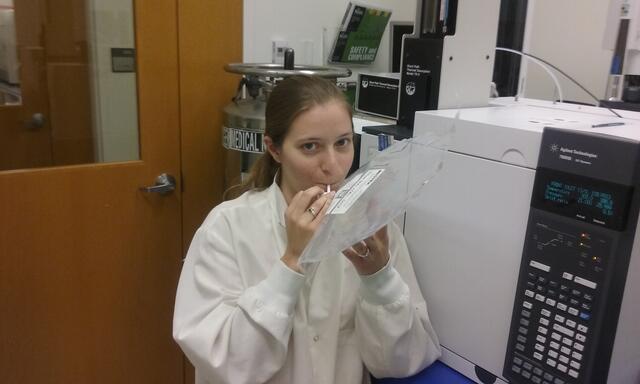Admission CTAs
Mason Researchers Sniff Out Sickness Through Volatile Organic Compounds
Mason researchers Robin Couch and Allyson Dailey are using volatile organic compound (VOC) fingerprints to sniff out sickness.
The team, part of Mason’s College of Science and Institute for Biohealth Innovation, have successfully diagnosed mice infected with Category A/B biothreat agents Francisella tularensis and Yersinia pestis through analysis of VOC profiles, as published in Nature Scientific Reports. They were even able to diagnose whether a mouse was exposed to a wildtype Y. pestis or an antibiotic-resistant strain.
“In essence, our technology determines the smell of samples. Healthy breath smells different than does sick breath,” Couch said. “Using mice, we could not only tell the mice were sick by their smell, but could also identify the source of the sickness.”
Within the biosafety level 3 laboratory on Mason’s Science and Technology Campus, mice were exposed to the pathogens in a whole-body aerosol chamber. The team collected the air in the cages beginning the day after exposure and processed the samples using a technique that the researchers call simultaneous multifiber headspace solid-phase microextraction (simulti-hSPME). The 6-fiber extraction device and processing methods that the team designed and patented allow for more comprehensive and rapid throughput than traditional techniques; the VOC fingerprint of each sample can be quickly identified from an air sample and compared to the fingerprints of cultured pathogens to determine the source of infection.
The increase in efficiency of testing that simulti-hSPME provides could mean lives saved, a poignant possibility in today’s healthscape. The team is in the early stages of collaborating with the Mason and Partners (MAP) Clinics in Manassas Park to apply the innovation to SARS-CoV-2 testing.
The collection method in this case is a bag with a tube that the patient blows up. The VOC fingerprint is then extracted from the breath sample to see if it matches the profile of COVID-19.
“Results are available in about one hour, which is faster than the FDA approved test,” Couch said. He added that the test is noninvasive compared to the FDA-approved nasal swab.

